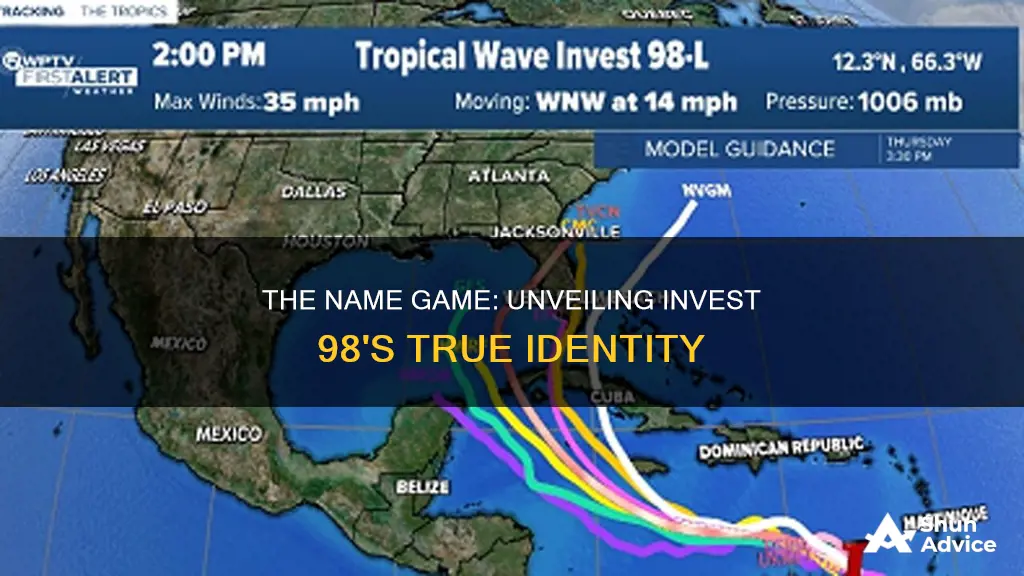
Invest 98L is a designated area of disturbed weather that is being monitored for potential tropical cyclone development. In meteorology, an invest (short for investigative area) is a region of disturbed weather that is being investigated by the National Hurricane Center (NHC). Invests are numbered from 90 to 99, followed by a suffix letter L in the North Atlantic basin, E in the Eastern Pacific basin, and C in the Central Pacific basin. The Invest 98L disturbance was located over the southeastern Caribbean Sea and had a 90% chance of developing into a tropical cyclone within the next two to five days.
| Characteristics | Values |
|---|---|
| Name | Invest 98L |
| Location | Over the southeastern Caribbean Sea |
| Chance of Development | 90% over the next two days and a 90% chance over the next five days |
| Forecast | Expected to move west-northwest across the eastern Caribbean Sea during the next day or two, and be over the central Caribbean Sea by the weekend |
| Potential Path | Gulf of Mexico |
What You'll Learn

Invest 98L's path
Invest 98L is the designation for a weather system that has a high likelihood of developing into a tropical depression or storm. As of September 21, 2022, Invest 98L was located in the eastern Caribbean Sea and was forecast to strengthen and enter the Gulf of Mexico.
Invest 98L was poorly organised due to higher wind shear in the area. However, as it travelled west through the weekend, it was expected to strengthen into a tropical depression or storm. By early the next week, forecast models predicted several possible paths for Invest 98L:
- Steered over the Yucatan Peninsula.
- Moving through the Yucatan channel.
- Passing over the western tip of Cuba and then into the Gulf of Mexico.
The GFS model predicted a more westerly track, indicating impacts along the western Gulf Coast. In contrast, the European model predicted an easterly track, bringing the storm closer to the west coast of Florida and Georgia.
The National Hurricane Center (NHC) declared Invest 98L an Investigation Area, and meteorologists ran spaghetti models to project its future track possibilities. The designation "Invest 98L" indicates that this weather system is in the Atlantic basin and is numbered from 90 to 99, with the "L" assigned to Atlantic Ocean or Gulf of Mexico disturbances.
Invest 98L had a 90% chance of developing into a tropical system over two days and a 90% chance over five days. Upper-level winds initially inhibited its development, but the environment was forecast to become more favourable within a few days, likely forming a tropical depression. The disturbance was predicted to move west-northwest across the eastern Caribbean Sea, reaching the central Caribbean Sea over the weekend.
While Invest 98L's path remained uncertain, meteorologists predicted several potential outcomes, including impacting the eastern Gulf of Mexico, Florida, Georgia, Louisiana, Mississippi, Alabama, or the Florida Panhandle. The system could also remain weak and continue west into the Yucatan Peninsula and Mexico mainland, likely missing Texas.
The Debt-Equity Dilemma: Navigating the Payoff Crossroads
You may want to see also

Potential impact on Florida
In meteorology, an "invest" is a designated area of disturbed weather that is being monitored for potential tropical cyclone development. Invest 98L officially formed on Friday morning and became Tropical Depression Nine, which was expected to enter the Gulf of Mexico the following week. While it is too soon to know exactly where Tropical Depression Nine will go and what areas could be impacted, meteorologists say that all the ingredients seem to be present for a large and powerful system to develop.
The National Hurricane Center called for a Category 3 hurricane – a major hurricane – approaching the west coast of Florida early to mid-next week. Hurricane Hunter aircraft will also help provide more accurate data on Invest 98L once they start flying through the system. The National Hurricane Center advised that there was a possibility of life-threatening inundation from rising water moving inland from the shoreline. They issued a hurricane warning 36 hours in advance of tropical storm-force winds to give people time to complete their preparations.
Florida's governor, Ron DeSantis, encouraged people across the state to be prepared for the likely impacts of Tropical Storm Nicole, which developed from Invest 98L. The Florida Division of Emergency Management and DeSantis were in contact with local officials from all counties in Florida. DeSantis advised people across the state to review their disaster preparedness plans, listen to all orders from local officials, know their evacuation zone, have multiple ways to receive weather alerts, and keep car gas tanks at least half full.
The potential impact on Florida from Invest 98L, now Tropical Storm Nicole, included the possibility of dangerous storm surges, damaging winds, heavy rainfall, strong winds, rough surf, and coastal flooding.
Retirement Accounts: The Illusion of a Secure Future
You may want to see also

Likelihood of development
In meteorology, an "invest" is a designated area of disturbed weather that is being monitored for potential tropical cyclone development. The likelihood of development of Invest 98L, also called Invest 98, into a tropical cyclone was assessed as high by meteorologists in September 2022.
On September 22, 2022, Invest 98L was reported to have a 90% chance of development over the next two days and a 90% chance of development over the next five days. The National Hurricane Center (NHC) stated that the environment was expected to become more favourable for development in a few days, and a tropical depression was likely to form.
The disturbance was forecast to move west-northwest across the eastern Caribbean Sea, reaching the central Caribbean Sea by the weekend. Computer models predicted that it would enter the Gulf of Mexico by mid-week, but the strength and path of the potential storm were still uncertain.
By September 23, 2022, meteorologists were monitoring how the system would interact with land, such as Cuba, before potentially entering the Gulf. It was noted that the passage between Mexico and Cuba could result in a stronger system. While the exact path remained unknown, it was likely that a system would be in the Gulf of Mexico the following week.
The NHC stated that the upper-level winds were inhibiting development at that time, but the environment was expected to become more favourable. This assessment indicated a high likelihood of Invest 98L developing into a tropical cyclone.
Don't Invest: When to Hold Off
You may want to see also

Gulf of Mexico's role
The Gulf of Mexico is an important natural, cultural, and economic feature for the five US states that surround it. It is also a significant body of water for Mexico and Cuba. The Gulf's economy is largely driven by its natural resources, including its diverse marine life, petroleum, and natural gas.
The Gulf of Mexico is a vital habitat for waterfowl and shorebirds, with substantial colonies of noddies, boobies, pelicans, and other seabirds. It is also home to the Caribbean manatee, a marine mammal whose numbers are declining. The Gulf's waters contain large populations of fish, with commercial fishing supplying approximately one-fifth of the total catch in the United States. Shrimp, flounder, red snapper, mullet, oysters, and crabs are the most commercially important species. Additionally, a large portion of the fish caught is used to create fish protein concentrate for animal feeds.
The Gulf's shallow continental shelf regions contain large deposits of petroleum and natural gas, providing a substantial proportion of domestic energy needs in the United States. These deposits have been extensively developed since the 1940s, with offshore wells drilled primarily in the waters off the coasts of Texas and Louisiana in the US, and in Mexico's Bay of Campeche. The infrastructure for oil and gas production in the Gulf of Mexico is the most developed in the world, with refineries, processing plants, supply and service bases, construction yards, and pipeline yards concentrated in the coastal areas of Louisiana and eastern Texas.
The Gulf of Mexico also plays a significant role in tourism and sport fishing. The Gulf Coast has become a popular tourist destination, especially during the winter months, with many coastal areas, particularly in Florida, developing into large retirement communities. Sport fishing, boating, swimming, and scuba diving are popular recreational activities in the Gulf.
The Gulf of Mexico's economic significance is further highlighted by the fact that each of the surrounding US states is increasingly targeting its resources for utilization and development. The Gulf is a vital link between the US and nearby nations, and its role in trade and investment is crucial.
Finding Your Investment Soulmate
You may want to see also

National Hurricane Center's role
The National Hurricane Center (NHC) is a division of the United States' NOAA/National Weather Service. It is responsible for tracking and predicting tropical weather systems between the Prime Meridian and the 140th meridian west, poleward to the 30th parallel north in the northeast Pacific Ocean and the 31st parallel north in the northern Atlantic Ocean. The NHC is co-located with the Miami branch of the National Weather Service and is situated on the campus of Florida International University in University Park, Miami, Florida.
The NHC's role in the designation of an "investigative area" or "invest" is to monitor areas of disturbed weather for potential tropical cyclone development. Once the NHC declares an investigative area, spaghetti models are run to project the future track possibilities and potential intensity of the system. It is important to note that the designation of an area as an "invest" does not necessarily indicate a high likelihood of tropical cyclone development.
The NHC issues routine marine forecasts in the form of graphics and high seas forecasts year-round. During the Atlantic and northeast Pacific hurricane seasons, the Hurricane Specialist Unit (HSU) within the NHC issues routine tropical weather outlooks for these regions. When tropical storm or hurricane conditions are expected within 48 hours, the NHC issues watches and warnings via the news media and NOAA Weather Radio.
The NHC also issues tropical cyclone advisory products at least every six hours, at 5 am, 11 am, 5 pm, and 11 pm EDT. When coastal tropical storm or hurricane watches or warnings are in effect, the NHC issues Tropical Cyclone Public Advisories every three hours. These advisories contain important information such as current coastal watches and warnings, the cyclone's position, maximum sustained winds, current motion, and a description of associated hazards.
In summary, the NHC plays a crucial role in monitoring, predicting, and providing timely information about tropical weather systems and potential cyclones. Through its various units and in coordination with other organizations, the NHC helps to ensure that the public and relevant authorities are prepared for and informed about potential tropical cyclone activity.
Invest Wisely: Picking the Right Path
You may want to see also
Frequently asked questions
An INVEST, short for "investigative area", is a designated area of disturbed weather that is being monitored for potential tropical cyclone development.
Invest 98L is a tropical wave in the Atlantic that could head toward the Gulf of Mexico. It is expected to become a tropical depression.
After Invest 98L forms, meteorologists will watch how it interacts with land, such as Cuba, before it enters the Gulf.







